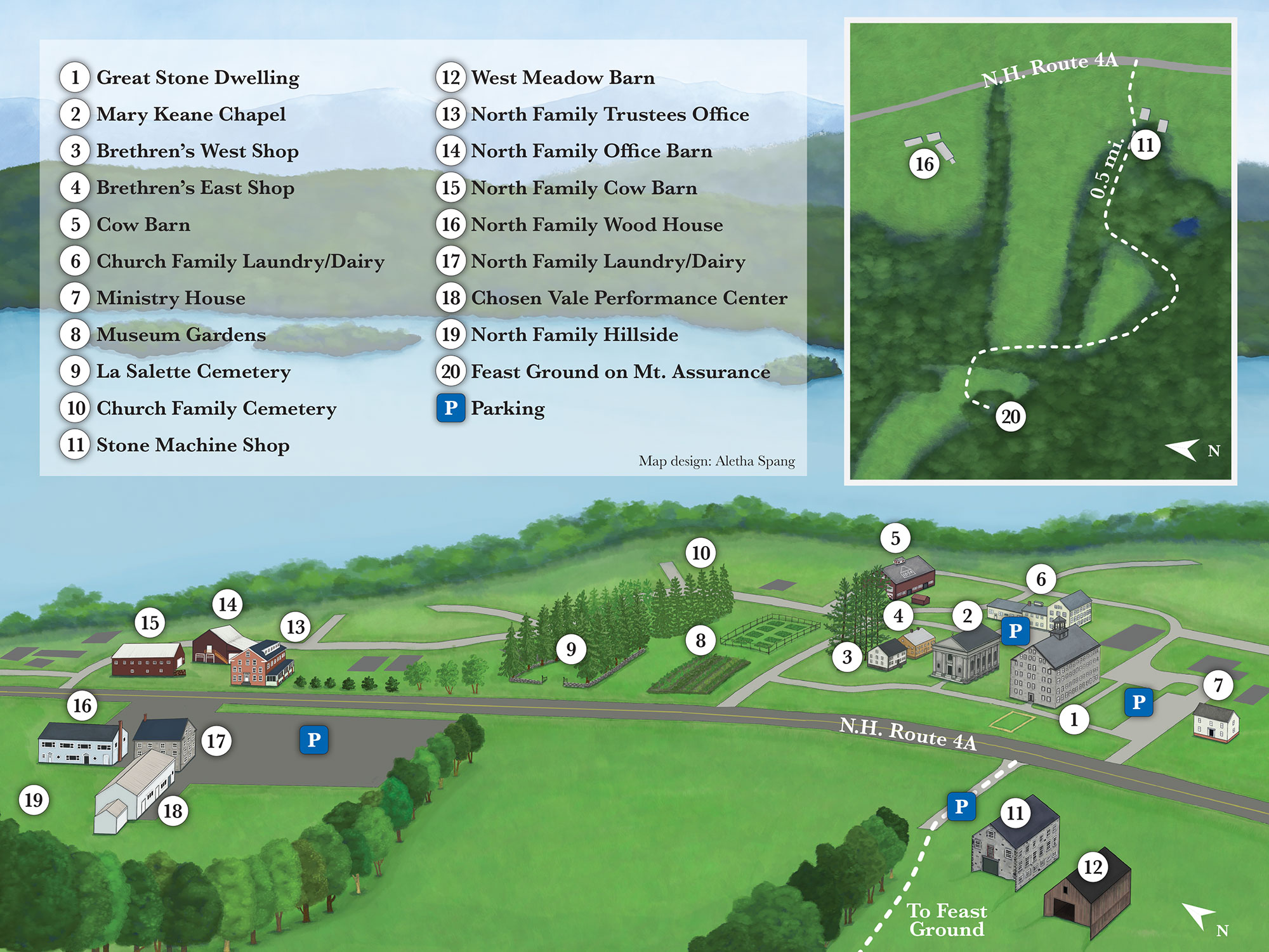Enfield Shaker Village Walking Tour
The Great Stone Dwelling
This massive granite structure was designed to house Enfield’s Church Family. It provided comfortable, efficient spaces for cooking, dining, sleeping, and worship, and it symbolized the Shakers’ aspirations for communal prosperity and spiritual perfection.
While the Shakers quarried the granite nearby and used local timber, the architect and many workmen were engaged from outside the Shaker community. Shaker Brethren spent over three years completing the meticulous interior fittings, creating spaces to reflect Shaker ideals of order and neatness.
The Great Stone Dwelling has long been a wonder to visitors.
Mary Keane Chapel
Mary Keane was the La Salette order’s benefactor, who donated her inherited fortune to purchase the former Shaker land, renovate the buildings, and build the chapel, where the La Salette community worshipped until the 1980s. Its stained-glass windows come from Germany and its organ from a famous Canadian organ builder.
Brethren’s West Shop
This workshop for Brethren had to be moved from its original location to make room for the Great Stone Dwelling. In the West Shop they constructed such items as ladles, scoops, and grain measures, for the community and for sale.
Brethren’s East Shop
This workshop for Brethren had to be moved from its original location to make room for the Great Stone Dwelling.The East Shop had various uses, including a tailor’s workshop where the Brethren made clothing.
Cow Barn
This is an example of a Shaker “Great Barn,” huge dairy barns built in the 19th century using a drive-through design. Farm wagons and carts enter up a ramp at one end to the highest level of the barn. The hay is then pitched down to the next level, the haymow (storage). From there the hay is pitched to the cows on the next level below, and finally, trap doors allow the cow waste to be shoveled down to the manure pits on the lowest level. Cows’ stalls, food, and water were heated, which increased their milk production.
Church Family Laundry/Dairy
The core of this three-part structure is the site’s oldest, least-altered. building. The three-story section, built in 1813 and expanded in 1833, housed the Laundry. The center section was the Dairy, where the Church Family Sisters made butter and cheese. Its lower story also dates from 1813, with a second story added in 1825, and a final later addition that included the rooftop cupola. The one-story wing to the north is a La Salette addition from 1944.
Ministry House
The Shaker New Hampshire Bishopric was comprised of the Enfield and Canterbury communities, overseen by the Bishopric Ministry. The Ministry traveled between the two communities—as well as to other Shaker villages—and resided and worked in this building when in Enfield. This was the last structure that the Shakers built at Enfield.
Museum Gardens
The Shakers grew well over 100 plant varieties for culinary, medicinal, and aromatic uses, as well as dyestuffs. They innovated the sale of garden seeds in small packages. This demonstration garden highlights plants grown by the Shakers.
La Salette Cemetery
Church Family Cemetery
Historically, each Shaker grave had its own marker. Eventually, a single granite gravestone inscribed “Shakers” replaced the individual stones. It simplified maintenance and symbolized the communal life the Shakers shared.
Stone Machine Shop
This Brothers’ workshop housed three floors of water-powered machinery. The wooden 1812 shop on the same location was lost to fire in 1849, driving the decision to rebuild in stone, which was quarried from within a five-mile radius.
West Meadow Barn
This barn was likely used for hay, and it may have housed animals on the lower level.
North Family Trustees Office
In this brick building the North Family Trustees conducted business matters with the outside world. The Trustees also resided here and hosted visitors from other villages.
North Family Office Barn
North Family Cow Barn
North Family Wood House
This building stored firewood for the community. At one time, the entire Enfield Shaker community was heated with wood, requiring 900 cords per winter. (A cord is a pile 8 feet long, 4 feet high and 4 feet wide. A full cord can weigh up to 5,000 pounds.)
North Family Laundry Dairy
Along with the laundry and dairy, this building housed several Sisters’ workshops.
Chosen Vale Performance Center
Used by La Salette as their chapel, this building today provides space for concerts, talks, and other events.
North Family Hillside
This land was used for agricultural purposes such as pasture, meadow, and orchard. Water from the pond powered the mills below. La Salette created an extensive devotional area on the hillside. This is now part of the Museum grounds and visitors are welcome to visit.
Feast Ground on Mount Assurance
Many Shaker communities constructed outdoor worship areas called “feast grounds” during a protracted period of intense spiritual revival in the 1840s. During that period each community adopted a “spiritual” name; Enfield’s was Chosen Vale.
Enfield’s feast ground was a 140-square- foot plateau built into a hillside above the village. The “feasts” held here were elaborate rituals that included singing, marching, and miming the act of eating delicious spiritual food.


